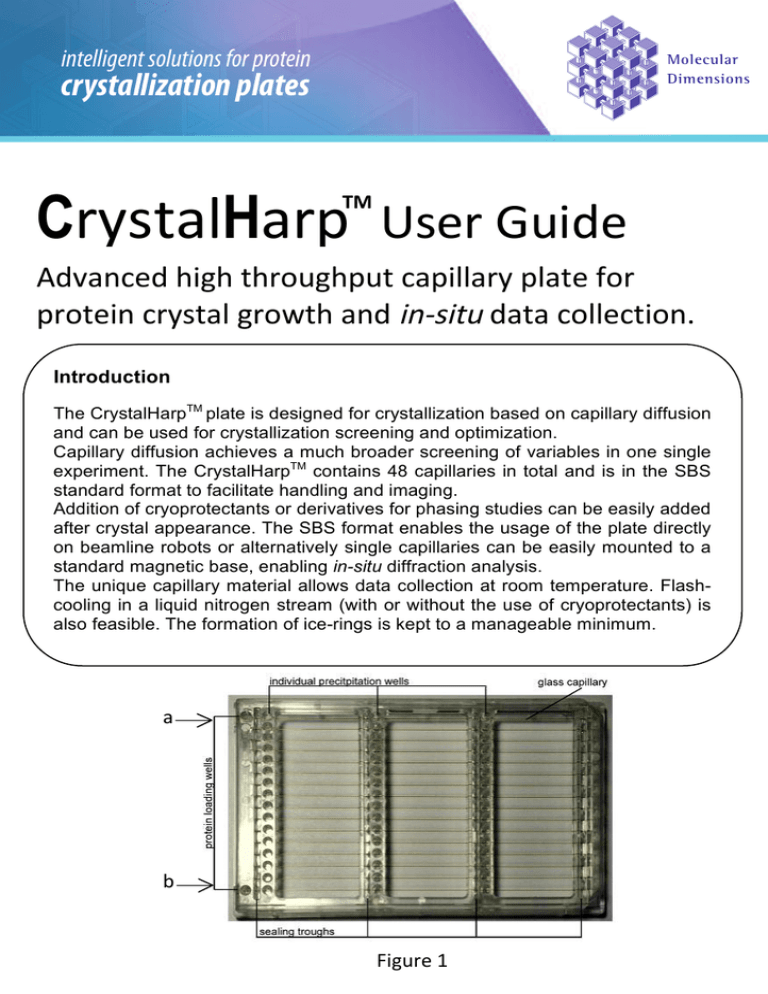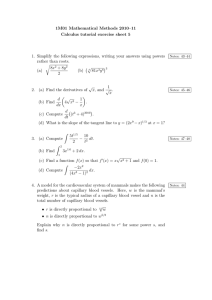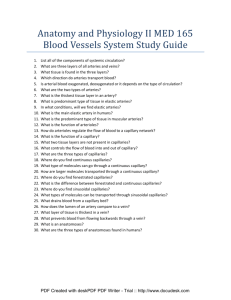CrystalHarp User Guide
advertisement

intelligent solutions for protein Molecular Dimensions crystallization plates C$%&'!(H!$) ""*&+$",-./+ "#! ! " 0/1!23+/"4.54"'4$6-54)-'"3!).((!$%")(!'+"76$" )$6'+.2"3$%&'!("5$68'4"!2/"!"#$!%&"/!'!"36((+3'.629" Introduction The CrystalHarpTM plate is designed for crystallization based on capillary diffusion and can be used for crystallization screening and optimization. Capillary diffusion achieves a much broader screening of variables in one single experiment. The CrystalHarpTM contains 48 capillaries in total and is in the SBS standard format to facilitate handling and imaging. Addition of cryoprotectants or derivatives for phasing studies can be easily added after crystal appearance. The SBS format enables the usage of the plate directly on beamline robots or alternatively single capillaries can be easily mounted to a standard magnetic base, enabling in-situ diffraction analysis. The unique capillary material allows data collection at room temperature. Flashcooling in a liquid nitrogen stream (with or without the use of cryoprotectants) is also feasible. The formation of ice-rings is kept to a manageable minimum. !" #" :.5-$+";" Thingsyouwillneedbeforeyoubegin: x x x x x x x x Microscope MultiͲchannelpipetteP100 PipetteP100 Pipettetips MineralOil(5mL)*(MD2Ͳ71) 2xMagneticcapswithCryoPins* Scissorsorcuttingtool*(MD7Ͳ520) CounterͲdiffusioncrystallizationscreen* (MultiXtal,MD1Ͳ65) x RubberͲtippedtweezers*(MD7Ͳ521) *theseitemscanbepurchasedseparatelyfromMolecular Dimensions. 1 Orient the CrystalHarpTM as shown in Step1. Pipette 22-23 µL of protein solution into one of the protein loading wells, a or b (as shown in Figure 1). The capillary is open at both ends. Apply a slight vacuum onto the opposite empty protein loading well with the 2 mL syringe provided. The protein runs quickly through the capillary system. This step is time dependent and is related to the viscosity of your protein sample. 2 3 Monitor the filling of the capillary with a microscope or by holding plate up to the light. !"#$%&'(#)**(+% ,-**&'(#)**(+% If the protein has run too far through the capillary (seen as air bubbles near original protein loading well) simply apply vacuum to where the protein was loaded initially. You can recover excess protein sample from the protein loading well with a pipette tip. 4 Break all capillaries in the first left hand sealing trough using the 2 mL syringe with the flat green nozzle. 5 Put the sealing paste (shown with brown tip) using the syringe needle into the first left hand sealing trough. Ensure the sealing paste completely encloses each broken end of the capillaries without any entrapped air bubble. Fill the entire trough to the top with sealing paste. Repeat step 4 and 5 for the three remaining troughs, one at a time. 6 Pipette 20 µL per well of crystallization condition into the precipitant wells* using a multi-channel pipette. NB. The first tip enters the well #1 and the second will be in #3. A second pipetting operation is used to fill wells 2, 4, 6 etc. Use the CrystalHarpTM scoring sheet to register the location of each condition to the respective location. *Ensure no air bubbles are trapped on the bottom of the well. 7 Break the capillary in the 48 precipitant wells - using a twisting motion - with the flat ended green syringe, one by one. The breaking is audible and can be checked with a microscope. To avoid crosscontamination clean the syringe tip after each cut with tissue wipe. 8 Drop of mineral oil The precipitant wells need to be sealed to avoid evaporation with a drop of mineral oil to each well. The CrystalHarpTM plate is ready for incubation. Imaging and X-ray analysis Manual inspection of crystal growth can be performed using a microscope. Alternatively the SBS formatted CrystalHarpTM plate allows for the usage of commercial automatic incubation and imaging systems. X-ray Diffraction Analysis on single capillaries – cutting of capillaries for data collection experiments. 9 For mounting the capillary segment a CryoPin (ID 0.2mm) that has been premounted to a standard magnetic base is required. (Shown in 9,(left). Samples of these are provided in the Starter Kit). 9b The desired capillary segment is removed from the plate using the cutting tool (provided in the Starter Pack) or a pair of small scissors. It is recommended to first cut the end near the precipitant well to avoid uncontrolled movement of the liquid in the capillary. 9c For room temperature studies- the whole capillary can be used, but for flash-cooled experiments, capillaries should be cut anywhere along the 3 cm length. For example, crystals shown in the following capillaries can be cut in the places indicated (dotted line). ! ! 10 Mounting of capillaries under flash-cooled conditions For flash-cooled capillaries, you need to have at least 5-7 mm of capillary left outside of the CryoPin when mounting *(shown below). This length is short enough to avoid the problem of being only partially immersed in the focused cryostream. To hold the capillary in place in the pre-mounted CryoPin - dip the CryoPin into the sealing paste prior to adding the capillary. The cut capillary segment is then stuck into the metal capillary without the addition of any glue or sealing the top end. Capillary With 5-7 mm left outside of CryoPin. 10 contd. The mounted capillary can now be flash-cooled in liquid nitrogen in the customary way, i.e. for freezing a loop. For placing the mounted capillary onto the goniometer (shown above, it is recommended to use a cryo tong designed for large pin heights (24mm). Mounting of capillaries at ambient conditions NB. For this method you do not need to have the 5 - 7 mm of capillary exposed. It can be any length. 11 If the capillary is not flash-cooled in liquid nitrogen (i.e. for transport or storage) we recommend sealing one end of the capillary segment with wax. The unsealed end is placed into the pre-mounted CryoPin and a drop of e.g. glue or sealing paste applied to fix the capillary segment containing the crystals. CrystalHarp Capillary CryoPin



